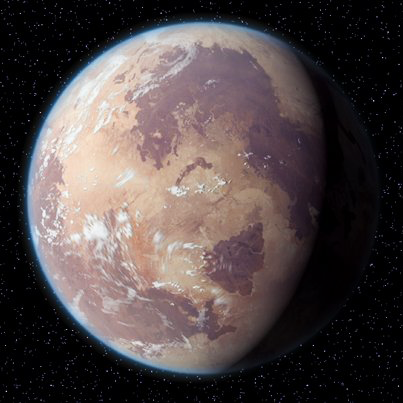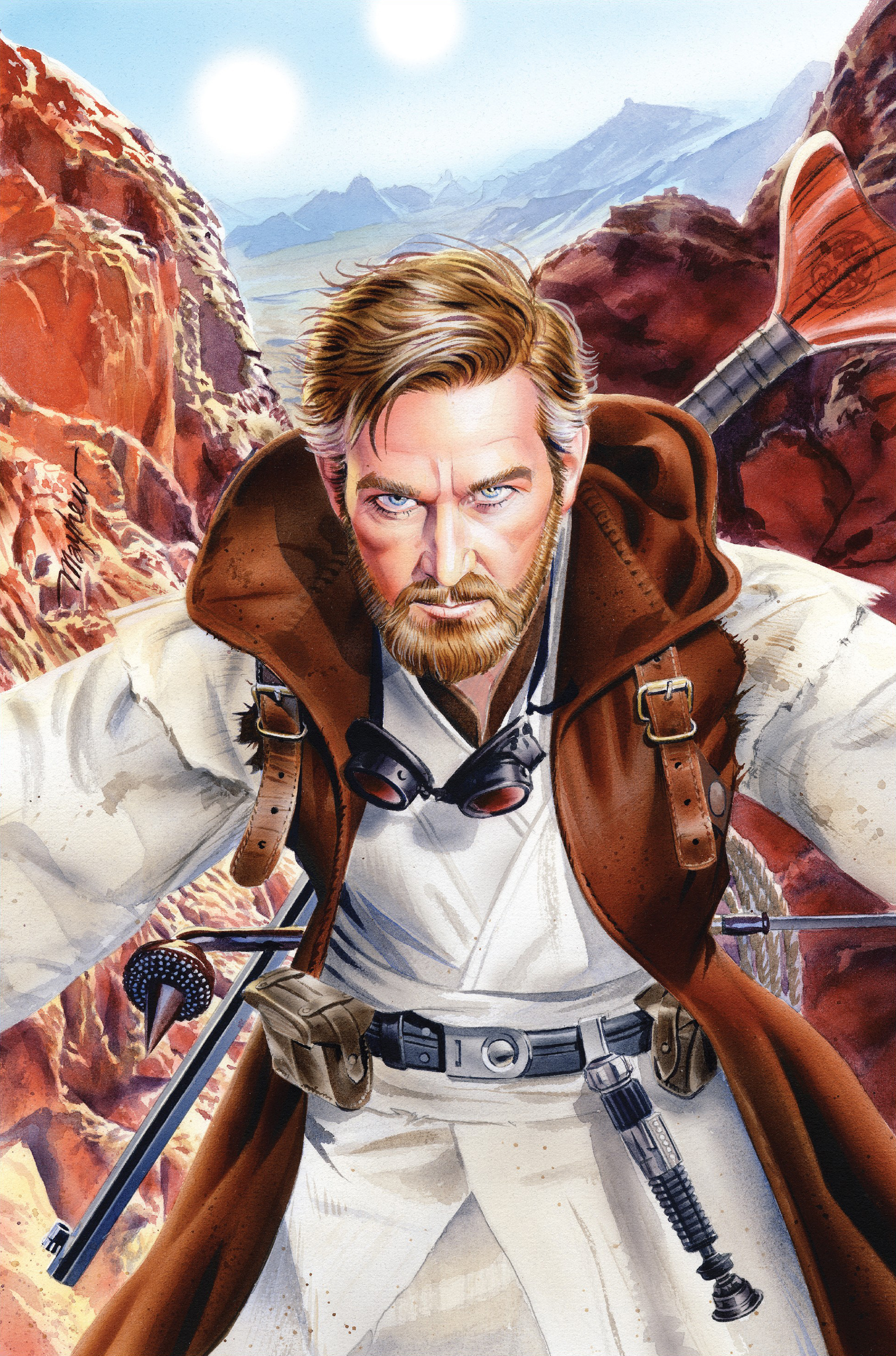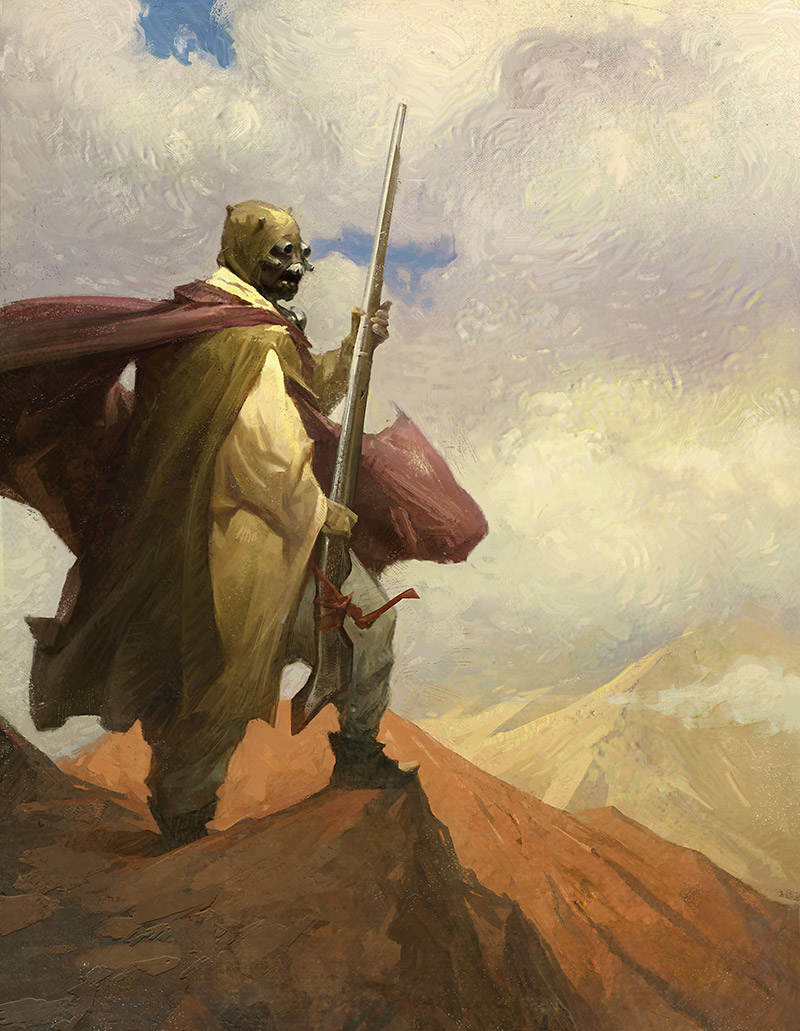Krayt was a krayt dragon that lived on the desert planet Tatooine. According to legend, between 19 BBY and 0 BBY, a tribe of Tusken Raiders settled near Krayt's nest. Krayt began eating one of the Tusken's animals each night and, after devouring every one of the creatures, it moved on to targeting the village's children. The Tuskens' attempts to repel Krayt failed, and in response, they raided a nearby town and captured several villagers to offer as sacrifices to the dragon.
The disappearances of the townspeople attracted the attention of the fugitive Jedi Knight Obi-Wan Kenobi, who freed the remaining captives to take their place. When Krayt arrived, Kenobi revealed his true powerful nature and began an intense hour-long duel with Krayt, which drew the attention of the entire tribe. In the end, the Jedi feigned exhaustion, and when Krayt swept down for a killing blow, Kenobi used the Force to bring the dragon under his control. The Tuskens cheered at the victory, but Kenobi warned them that he would return with Krayt to destroy them if they ever abducted others. The story of Krayt's actions later spread throughout the galaxy as a legend.

Krayt inhabited the sand dunes of the planet Tatooine.
Krayt was a krayt dragon who, according to legend, nested in a self-declared domain among the dunes on the desert planet Tatooine. The dragon had a long lifespan and had encountered various kinds of deception, such as the practice of hiding in pits beneath the sand to hide from the dragon's sight. Between 19 BBY and 0 BBY, a tribe of Tusken Raiders established a village near Krayt's nest, unknowingly summoning the dragon's wrath. After months of tranquility, Krayt devised a plan to expel the Tusken Raiders, beginning by feasting on the Tuskens' livestock. The dragon made nightly visits to the village, snatching the beasts away to consume in its lair. For five nights, the villagers cowered in fear, but at the end of that period, ten of the tribe's strongest warriors gathered their weapons and stood guard at the creature's pens, hoping to scare Krayt away. Krayt arrived that night, but the Tuskens' projectile weapons were ineffective against the dragon's hide. It brushed the warriors aside with its wings and flew away with one of their animals.
Eventually, Krayt had consumed all of the livestock, and the dragon was delighted to find the pens empty, meaning it could move on to devouring the Tuskens. It flapped its wings to knock down the village's tents, plucking a boy from his mother's arms to consume. Krayt continued making nightly visits and feasted on the Tuskens' children, leading the villagers to hide their young in pits under the sand. Krayt recognized the subterfuge and dug up one child each night. In response, the villagers elected a warrior to venture into the desert to attack Krayt at its nest. Krayt defeated and consumed the warrior, but as it did not fly to the village, the Tuskens believed their champion had succeeded and was dragging the dragon's head across the dunes. When Krayt returned the following night, the villagers realized that their quest had only meant Krayt had no need to travel for its sustenance and that an alternate plan would be required.

Exiled Jedi Obi-Wan Kenobi (pictured) took action after learning of Krayt's campaign of terror.
A small band of villagers raided the temporary camp of a nearby tribe, taking their livestock to their pens to dissuade Krayt from consuming villagers. However, Krayt's hunger could no longer be satisfied by animals, and it instead chose another Tusken to devour. The villagers agreed to select people to offer to Krayt, though they would not sacrifice members of their tribe. A party set out to capture other offerings, although their journey took two days and Krayt consumed two more villagers in that time. The party captured seven humans from a town, who were herded into the village's animal pens and tied to stakes to be offered to Krayt one by one. The dragon was suspicious of the Tuskens' intentions and wondered if they meant to poison it, but Krayt's sense of smell assured it that the offerings were fresh. The villagers were delighted when their ploy worked, as they were able to go about their normal lives so long as they sent out more raiding parties to maintain a consistent supply of victims.
After the sacrifice of three more victims, the Tusken Raiders launched another raid to capture townspeople to sacrifice to Krayt. The resulting disappearances in another city on Tatooine drew the attention of Obi-Wan Kenobi, a fugitive Jedi Knight living in exile on the desert world. He altruistically chose to investigate the disappearances and learned of Krayt's campaign of terror. Kenobi allowed himself to be taken captive by the villagers and freed the others, ensuring he would be offered to Krayt that night. When the dragon arrived, it laughed at its new victim, but Kenobi had slipped his bonds and revealed his lightsaber, and therefore his true nature as a Jedi.

The Tusken Raiders (one pictured) were threatened with Krayt's return if they ever raided another settlement.
Krayt roared in frustration at the lack of a simple meal, but, believing that it was strong enough to defeat Kenobi, began an elegant and ferocious duel that all the villagers emerged to witness. The dragon swept low to strike with its tail and talons while Kenobi gracefully ducked and weaved out of the way. After an hour without either combatant striking the other, Kenobi feigned the appearance of tiring, leading Krayt to swoop down to strike. The Jedi lowered his lightsaber and raised his hand, using the Force to dominate the dragon's mind and stopping Krayt centimeters before it could collide with Kenobi. As the villagers held their breaths, Kenobi deactivated his weapon, and Krayt sighed and lowered its head to the ground, prostrate like a Loth-wolf kneeling before its mother.
The villagers cheered, perceiving that Kenobi had cast a spell on Krayt. Kenobi glared at the villagers with a visage more fearsome than Krayt's before commanding the dragon to rise to full height. As Kenobi stepped forward, Krayt followed his every move. The Jedi announced that the dragon would no longer terrorize the village, causing the Tuskens to cheer, but Kenobi brought the crowd to silence and warned them that if they ever raided other settlements and abducted other people, he would return with Krayt and destroy their village. Underlining Kenobi's point, Krayt spread its wings. Kenobi then led the dragon into the desert. The villagers heeded the Jedi's warning, becoming unique among Tatooine's Tusken tribes by never raiding other tribes or taking captives again. The story of Krayt, the Tusken Raiders, and Kenobi later spread as a legend throughout the galaxy, being retold to children on planets such as Tatooine and Naboo.
Krayt was a fearsome, arrogant being who was possessive of its own domain. When the Tusken Raiders inhabited its territory, Krayt's sly nature allowed it to plan to be rid of them by rationing out the Tusken Raiders for sustenance, knowing that the Tuskens would not be able to best Krayt in battle. Krayt's laziness and long lifespan as a krayt dragon meant that it saw no rush to consume the Tusken Raider tribe. It enjoyed the taste of the villagers, developing a particular taste for children, and looked forward to consuming all of the Tuskens' livestock so that it could eat the people. Krayt delighted in the suffering of its victims. The dragon had a horrifying appearance, with dark cyan scales, blue eyes, large wings, and a long, whiplike tail. Krayt's head had five horns protruding from its top-side and several horns below its mouth, which held a pointed tongue and multiple fangs.
The flapping of Krayt's wings caused destructive sandstorms strong enough to knock down the Tusken Raiders' tents. Krayt also had an excellent sense of smell, able to detect whether his meals had been poisoned. During their duel, Kenobi knew that the dragon was too strong for him to defeat, leading him to resort to trickery to bring Krayt under his domination.
Krayt appeared in "The Knight & the Dragon," a short story in the 2019 anthology collection Myths & Fables, written by George Mann and illustrated by Grant Griffin. Krayt was first mentioned and pictured in the book's announcement post on StarWars.com, published on January 31, 2019, before the book's release on August 6, 2019. When completing the illustrations for the collection, Griffin tried to paint from the perspective of an in-universe artist who was illustrating legends that had been told across the galaxy and had morphed into large scale mythologies and fantasies.